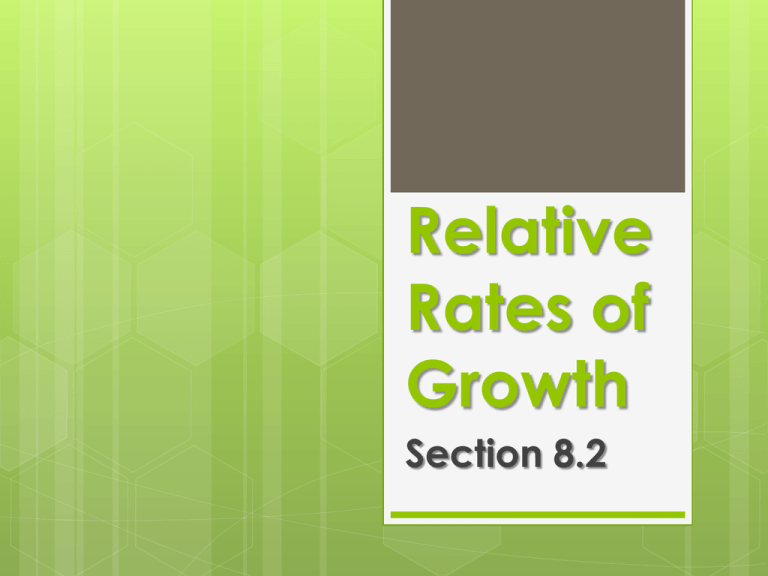Relative Rates of Growth
advertisement

Relative Rates of Growth Section 8.2 Comparing Rates of Growth x The exponential function e grows so rapidly and the natural logarithm function ln x grows so slowly that they set standards by which we can judge the growth of other functions... x As an illustration of how rapidly e grows, imagine graphing the function on a board with the axes labeled in centimeters… e 3 cm high. 6 At x = 6 cm, the graph is e 4 m high. 10 At x = 10 cm, the graph is e 220 m high. At x = 1 cm, the graph is 1 At x = 24 cm, the graph is more than half way to the moon. 43 At x = 43 cm, the graph is e 5.0 light-years high (well past Proxima Centauri, the nearest star to the Sun). Faster, Slower, Same-rate Growth as x Let f (x) and g(x) be positive for x sufficiently large. 1. f grows faster than g (and g grows slower than f ) as x if f x lim x g x or, equivalently, if 2. f and g grow at the same rate as f x lim L0 x g x g x lim 0 x f x x if (L finite and not zero) Faster, Slower, Same-rate Growth as x According to these definitions, y 2 x does not grow faster than y x as x . The two functions grow at the same rate because 2x lim lim 2 2 x x x which is a finite nonzero limit. The reason for this apparent disregard of common sense is that we want “f grows faster than g” to mean that for large x-values, g is negligible in comparison to f. Transitivity of Growing Rates If f grows at the same rate as g as x and g grows at the same rate as h as x , then f grows at the same rate as h as x . Guided Practice Determine whether the given function grows faster than, at the same rate as, or slower than the exponential function as x approaches infinity. 5 2 x 5 2 Our new rule: lim x e x x x 5 lim 0 x 2e Grows slower than (because the base is less than one!) e as x x Guided Practice Determine whether the given function grows faster than, at the same rate as, or slower than the exponential function as x approaches infinity. x ln x x x 1 x ln x 1 x ln x x lim lim x x x x e e ln x 1x 0 lim x lim x 0 x e x e Grows slower than e as x x Guided Practice Determine whether the given function grows faster than, at the same rate as, or slower than the squaring function as x approaches infinity. x 3 3 x 3 3 lim 2 lim x 2 0 x x x x 3 Grows faster than x as x 2 Guided Practice Determine whether the given function grows faster than, at the same rate as, or slower than the squaring function as x approaches infinity. x 5x 4 x 5x 5 x 5x lim 1 lim lim 3 4 2 x x x x x x 1 0 1 2 Grows at the same rate as x as x 4 4 Guided Practice Determine whether the given function grows faster than, at the same rate as, or slower than the squaring function as x approaches infinity. 2 x ln 2 2 ln 2 2 2 lim lim 2 lim x x x x 2 2x 2 x x 2 Grows faster than x as x 2 x Guided Practice Determine whether the given function grows faster than, at the same rate as, or slower than the natural logarithm function as x approaches infinity. log x ln x ln10 log x log x lim lim lim x x 2 ln x x ln x 2 ln x 1 2 ln10 Grows at the same rate as ln x as x Guided Practice Show that the three functions grow at the same rate as x approaches infinity. f1 x x 3 x 2x 1 f2 x x 1 4 2 2x 1 f3 x 2 x 1 5 Compare the first and second functions: x 2x 1 4 2 x 2x 1 f2 x x 1 lim lim lim 4 3 3 x x x f x x x x 1 1 Rational Function Theorem! 1 1 4 2 Compare the first and third functions: 2 x5 1 5 2 f3 x 2x 1 2 x 1 lim lim lim 5 2 3 3 x x f x x x x x 1 1 By transitivity, the second and third functions grow at the same rate, so all three functions grow at the same rate!







